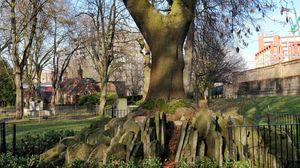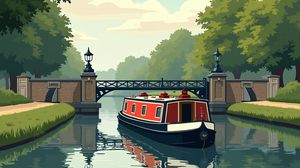
The Hardy Tree, located at St Pancras Old Church in London, is a fascinating and historically significant site. It holds an intriguing connection to the acclaimed English novelist and poet Thomas Hardy. Prior to gaining fame as a writer, Hardy worked as an architectural apprentice, and it was during this period in the mid-1860s that he was tasked with overseeing the exhumation and relocation of graves from the St Pancras churchyard.
The reason for this unconventional project was the expansion of the nearby railway lines. Large sums of human remains were moved to clear the path for what would become the Midland Railway. The headstones were placed in a circular pattern around an ash tree, giving rise to what is now known as the Hardy Tree. Over time, nature took its course, and the tree's roots entwined with the headstones, creating a striking and somewhat eerie visual blend of stone and wood.
This unusual configuration of the Hardy Tree is a poignant reminder of the history and change that has characterized London over the centuries. It is a symbol of how the old can coexist with the new in one of the world's most dynamic cities. The tree and its encircling stones evoke a sense of timelessness, bridging the gap between the Victorian era and the present day.
An interesting point to note is that while the Hardy Tree has become something of a pilgrimage site for literary fans and history buffs alike, its existence can be seen as a testament to the period's pragmatic approach to urban development. The arrangement of the headstones, entwined intimately with the ash tree's roots, is an unintended work of art created through the serendipitous interaction of human and natural efforts.
The Hardy Tree's presence in St Pancras Old Churchyard adds additional layers of intrigue and solemnity to this already historic site. As one of the oldest surviving Christian worship sites in England, St Pancras Old Church and its grounds offer a rare glimpse into the city's rich past, with the Hardy Tree serving as a unique focal point that continuously draws interest from both locals and tourists.

Making the Most of Your Visit:
Visit during the morning or early afternoon when the lighting is best for photographs. The interplay of light through the trees and onto the ancient headstones creates a truly haunting image that photographers adore.
If you're interested in the literary connection, take some time to read up on Thomas Hardy's life and work beforehand. Recognizing the connection between his architectural past and his later literary achievements gives the site an added layer of interest.
While you're there, wander around the rest of the St Pancras Old Churchyard. The combination of ancient graves, historical significance, and quiet atmosphere makes it a peacefully reflective escape from the city's hustle and bustle.
Keep an eye out for the quiet corner of the yard where the Hardy Tree is located. It's easy to overlook if you're rushing, but slow down and enjoy the peacefulness of this secluded part of the churchyard.
Notice how nature has interacted with history. Observing how the tree's roots have grown over and around the headstones gives a poignant insight into how time and nature alter human landscapes.

Visiting Times & Costs:
The Hardy Tree is located within the grounds of St Pancras Old Churchyard in London, which is open to the public.
Opening Times:
- Typically open daily, but check for any seasonal changes or special closures that might affect accessibility.
Entrance Fee:
- Access to St Pancras Old Churchyard and the Hardy Tree is usually free of charge.
Accessibility:
- The area surrounding the Hardy Tree is generally accessible to most visitors, but be aware that the churchyard paths may be uneven, which could present challenges for those with mobility impairments.

Address & Map:

Nearby:























